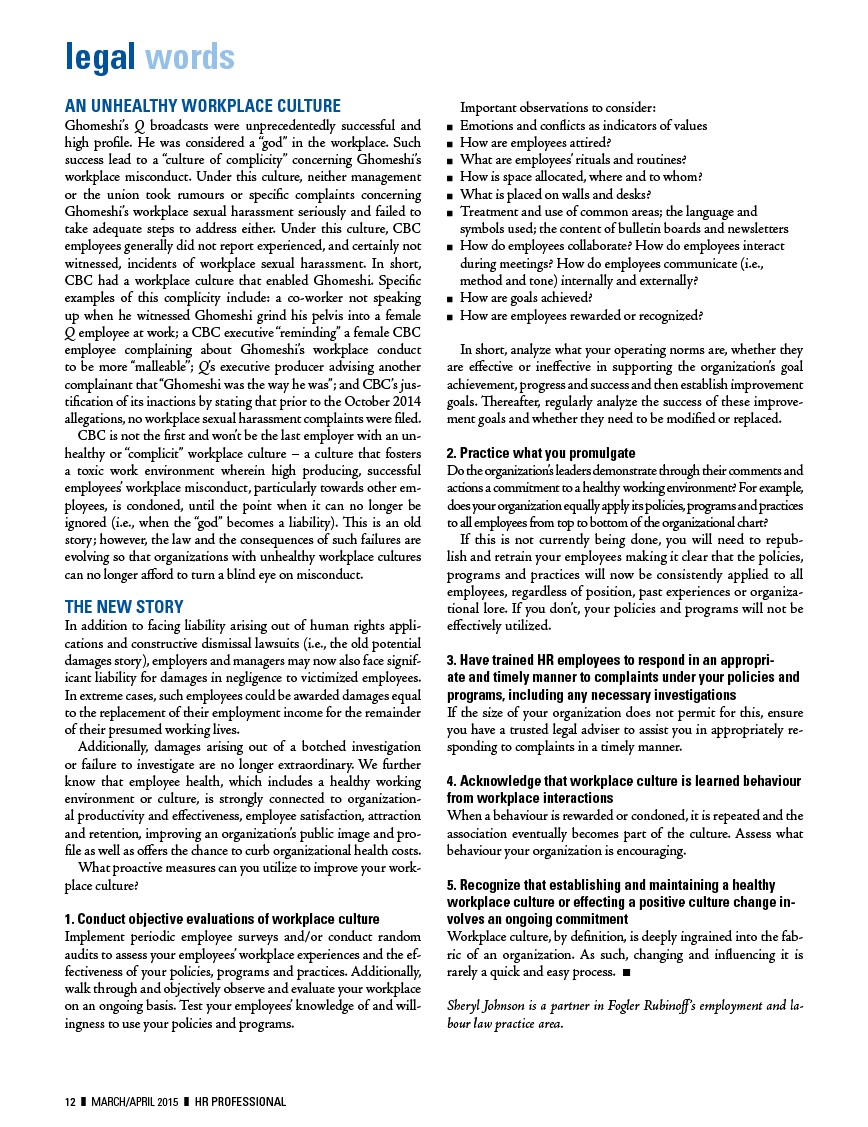
AN UNHEALTHY WORKPLACE CULTURE
Ghomeshi’s Q broadcasts were unprecedentedly successful and
high profile. He was considered a “god” in the workplace. Such
success lead to a “culture of complicity” concerning Ghomeshi’s
workplace misconduct. Under this culture, neither management
or the union took rumours or specific complaints concerning
Ghomeshi’s workplace sexual harassment seriously and failed to
take adequate steps to address either. Under this culture, CBC
employees generally did not report experienced, and certainly not
witnessed, incidents of workplace sexual harassment. In short,
CBC had a workplace culture that enabled Ghomeshi. Specific
examples of this complicity include: a co-worker not speaking
up when he witnessed Ghomeshi grind his pelvis into a female
Q employee at work; a CBC executive “reminding” a female CBC
employee complaining about Ghomeshi’s workplace conduct
to be more “malleable”; Q’s executive producer advising another
complainant that “Ghomeshi was the way he was”; and CBC’s justification
of its inactions by stating that prior to the October 2014
allegations, no workplace sexual harassment complaints were filed.
CBC is not the first and won’t be the last employer with an unhealthy
or “complicit” workplace culture – a culture that fosters
a toxic work environment wherein high producing, successful
employees’ workplace misconduct, particularly towards other employees,
is condoned, until the point when it can no longer be
ignored (i.e., when the “god” becomes a liability). This is an old
story; however, the law and the consequences of such failures are
evolving so that organizations with unhealthy workplace cultures
can no longer afford to turn a blind eye on misconduct.
THE NEW STORY
In addition to facing liability arising out of human rights applications
and constructive dismissal lawsuits (i.e., the old potential
damages story), employers and managers may now also face significant
liability for damages in negligence to victimized employees.
In extreme cases, such employees could be awarded damages equal
to the replacement of their employment income for the remainder
of their presumed working lives.
Additionally, damages arising out of a botched investigation
or failure to investigate are no longer extraordinary. We further
know that employee health, which includes a healthy working
environment or culture, is strongly connected to organizational
productivity and effectiveness, employee satisfaction, attraction
and retention, improving an organization’s public image and profile
as well as offers the chance to curb organizational health costs.
What proactive measures can you utilize to improve your workplace
culture?
1. Conduct objective evaluations of workplace culture
Implement periodic employee surveys and/or conduct random
audits to assess your employees’ workplace experiences and the effectiveness
of your policies, programs and practices. Additionally,
walk through and objectively observe and evaluate your workplace
on an ongoing basis. Test your employees’ knowledge of and willingness
to use your policies and programs.
Important observations to consider:
■■ Emotions and conflicts as indicators of values
■■ How are employees attired?
■■ What are employees’ rituals and routines?
■■ How is space allocated, where and to whom?
■■ What is placed on walls and desks?
■■ Treatment and use of common areas; the language and
symbols used; the content of bulletin boards and newsletters
■■ How do employees collaborate? How do employees interact
during meetings? How do employees communicate (i.e.,
method and tone) internally and externally?
■■ How are goals achieved?
■■ How are employees rewarded or recognized?
In short, analyze what your operating norms are, whether they
are effective or ineffective in supporting the organization’s goal
achievement, progress and success and then establish improvement
goals. Thereafter, regularly analyze the success of these improvement
goals and whether they need to be modified or replaced.
2. Practice what you promulgate
Do the organization’s leaders demonstrate through their comments and
actions a commitment to a healthy working environment? For example,
does your organization equally apply its policies, programs and practices
to all employees from top to bottom of the organizational chart?
If this is not currently being done, you will need to republish
and retrain your employees making it clear that the policies,
programs and practices will now be consistently applied to all
employees, regardless of position, past experiences or organizational
lore. If you don’t, your policies and programs will not be
effectively utilized.
3. Have trained HR employees to respond in an appropriate
and timely manner to complaints under your policies and
programs, including any necessary investigations
If the size of your organization does not permit for this, ensure
you have a trusted legal adviser to assist you in appropriately responding
to complaints in a timely manner.
4. Acknowledge that workplace culture is learned behaviour
from workplace interactions
When a behaviour is rewarded or condoned, it is repeated and the
association eventually becomes part of the culture. Assess what
behaviour your organization is encouraging.
5. Recognize that establishing and maintaining a healthy
workplace culture or effecting a positive culture change involves
an ongoing commitment
Workplace culture, by definition, is deeply ingrained into the fabric
of an organization. As such, changing and influencing it is
rarely a quick and easy process. ■
Sheryl Johnson is a partner in Fogler Rubinoff’s employment and labour
law practice area.
legal words
12 ❚ MARCH/APRIL 2015 ❚ HR PROFESSIONAL